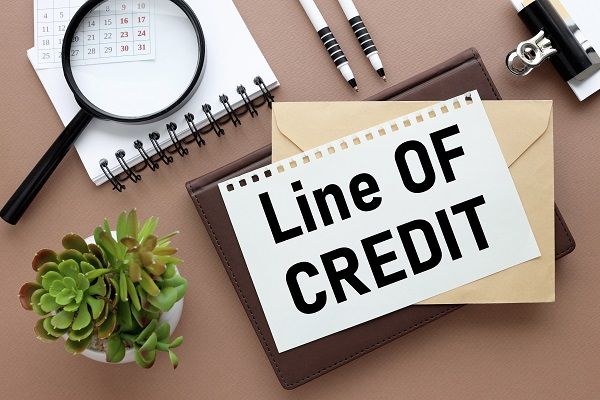Line of Credit (LOC) – What is It and How to Apply?

What is a Line of Credit (LOC)?
A line of credit is a type of loan that allows you to borrow money up to a certain limit. Unlike a traditional loan, which provides you with a lump sum of money all at once, a line of credit gives you the flexibility to borrow only what you need, when you need it.
Lines of credit are often used for short-term borrowing needs, such as covering unexpected expenses or bridging a temporary cash-flow gap. They can also be used for longer-term financing, such as financing a small business or home renovation project.
How Does a Line of Credit Work?
In case you apply for a line of credit, the service provider/financial institution will check whether you are eligible to avail of a credit line or not. The main eligibility criteria are a good CIBIL score, preferably above 750, and a stable income.
After a borrower qualifies for a credit line, there will be a set period called the ‘draw period’. The borrower can withdraw money from the LOC (Line of Credit) account during the draw period. As per a borrower’s convenience and need, the financial institution will transfer the money via card, cheque, or account transfer.
After a borrower starts withdrawing money, interest starts getting accrued. Once the borrower starts making repayments, the amounts repaid will be added to the LOC account. After the end of the draw period, the repayment period will start.
The borrower will have to repay the remaining balance if applicable.
Different Types of Line of Credit
There are primarily two types of lines of credit – unsecured line of credit and secured line of credit. Let’s understand these in detail.
1. Unsecured Line of Credit
This is also known as a revolving credit account. The financial institution sanctions an unsecured credit line after checking a person’s credit score and income. One doesn’t need to pledge any collateral to avail of it. However, the interest rate is high because the borrower doesn’t have to pledge assets.
Unsecured Line of credit can be further divided into the following:
- Personal Line of Credit: A personal line of credit is a type of revolving credit that allows individuals to borrow funds on an as-needed basis, up to a pre-approved limit. It works in a similar way to a credit card but typically offers lower interest rates and higher credit limits. With a personal line of credit, borrowers can withdraw funds as and when they need them, up to the approved credit limit. Interest is only charged on the amount borrowed and not on the entire credit limit. Once the borrowed funds are repaid, the credit line becomes available again for future use.
- Business Line of Credit: A business line of credit is a type of financing that provides businesses with access to a predetermined amount of capital that they can draw upon as needed. It works in a similar way to a personal line of credit but is designed specifically for business purposes. With a business line of credit, businesses can borrow funds on an as-needed basis, up to the pre-approved credit limit. Interest is only charged on the amount borrowed, and once the funds are repaid, the credit line becomes available again for future use. This makes it a flexible form of financing that can help businesses manage their cash flow and cover unexpected expenses.
2. Secured Line of Credit
When a borrower avails of a loan of credit against collateral, it is known as a secured credit line. In such cases, failure to repay would be followed by liquidation of the assets.
Also Read
How to Apply for a Line of Credit?
Given below are the steps to apply for a line of credit:
- Step 1: Visit the nearest branch of your chosen lender
- Step 2: Fill up the required form and attach the necessary documents
- Step 3: The bank will check your credit score and income to gauge your creditworthiness
- Step 4: The bank will sanction the LOC after you qualify for the same
What is the Repayment Procedure of LOC?
LOC repayment is similar to credit card repayment. A repayment deadline will be set after you have cashed out a portion of your loan’s credit limit. Meanwhile, if you require additional funds before repaying the first, you can obtain them without difficulty.
For example, if you have LOC of ₹2 lakh and you cash out ₹20,000 you will have to pay interest for only ₹20,000 and not for ₹2 lakh. After you take out ₹20,000 loan a deadline will be set for repayment in easy EMI (Interest + Principal amount). And in the meantime, if you need ₹40,000 more, the total interest will be charged on ₹60,000 which you need to repay within the specified timeframe.
How to Track Your Line of Credit?
The monthly statement sent by the bank allows you to easily track your LOC. Though the bank can send you the statement in a variety of ways, in this paperless banking era, banks usually prefer to send e-statements to your registered email address. Always check your statement every month or quarterly, depending on which mode you chose, to keep track of it. Check the remaining balance before applying for a new loan, as it is necessary to pay off any outstanding debts before applying for a new one. If you have any questions, you can contact the bank’s executives at any time by dialing the bank’s customer service number.
How to Select the Right Bank for LOC?
In India, several banks offer Lines of Credit to their customers. Before making a final decision as a borrower, you must read their terms and conditions. Compare the interest rates of all the major banks, and personally visit each of them to learn about any hidden clauses. Use online websites to determine the interest rate of each bank and select the lowest interest rate to reap the most benefits. You should also check to see if the bank offers draught protection. Overdraft will be linked to your account, so if you run out of funds, your overdraft facility will come to your aid. You should also compare the fees for the overdraft facility offered by the banks.
Benefits of Line of Credit
Here are a few benefits of line of credit:
- You can borrow only the amount you require without having to pay interest on the entire credit line.
- Borrowers can get flexible repayment options for the principal amount on LOC as long as they pay the interest and other fees.
- Some financial institutions offer the option of secured LOC, which has lower interest rates.
- LOCs can be approved for use over a long tenure of up to three years. During this time, customers can redraw their limits multiple times without incurring additional charges.
- These are ideal for long-term projects with a wide range of unpredictable costs. Also, a LOC is useful to address short-term cash shortages.
- The interest rates for LOC are usually lower than those offered by credit cards, payday loans or cash advances.
- Borrowers can get access to a credit line in a few minutes, making it an ideal option for those who cannot get access to credit cards.
Disadvantages of a Line of Credit
However, there are a few drawbacks to line of credit.
- Borrowers may face difficulty in repayment if interest rates increase.
- Registration fees are applicable.
- LOC is a liability that can restrict the borrower from availing of another loan.
- Resisting the temptation to splurge is difficult because money is readily available.
Difference between Line of Credit and Personal Loans
The table below provides the differences between a credit line and a personal loan:
| Line of Credit | Personal Loan |
| This is a revolving account that enables people to draw, repay and redraw money at their convenience | This is a lump sum amount which is paid back over a fixed tenure |
| One can avail of the requisite amount whenever they want via a cheque/card/account transfer | One receives the entire loan amount after it has been sanctioned |
When to Use a Line of Credit?
Given below are important points about when it’s most appropriate to use a line of credit:
- You can avail a line of credit to fund your education and home renovation
- You can also avail this loan to pay off small debts
When Not to Use a Line of Credit?
Discussed below are important points about when it is not a good idea to use a line of credit:
- If the borrower has an irregular and unstable source of income, using a line of credit is not a good idea
- A line of credit is not an ideal option to fund daily financial needs because having new debts is not a good idea
- A cash loan might be a better idea if the borrower is sure of the amount they would need but doesn’t want to pledge his assets.
Final Word
A line of credit is a versatile loan option that benefits both borrowers and lenders. Depending on your needs, you can choose between a secured and an unsecured credit line. The terms and conditions of a LOC are convenient, and repaying the loan will not be difficult. To apply for and obtain a credit line, you must have a good credit score.
In case you want quick access to credit to meet your financial requirements, apply for Navi Cash Loan instantly in a 100% paperless process at affordable rates. Download the Navi App to explore more!
FAQs
Business credit lines are availed by various companies to address their working capital requirements, payment of salaries, inventory requirements, etc. These are not as flexible as a personal LOC as spending is limited to business-related expenses.
A personal LOC is offered to individuals with a high credit score (above 700) and a good debt utilisation ratio. Individuals can use this credit facility to meet their urgent or long-term expenses. Borrowers can pledge collateral to get better loan terms.
Yes, since small startup businesses are prone to losses and emergencies, a LOC is a great choice for them. Moreover, estimating a final value for how much funds a business requires is next to impossible. By having a credit line sanctioned, a startup can get access to instant cash during cash flow crunches.
Credit lines offer more flexible options for repayment over longer tenures compared to credit cards. They also come with lower interest rates than credit cards, which can charge anywhere from 36-42% for not paying dues on time. However, a LOC does not offer the convenience of credit cards, such as flexible transaction or repayment features.
Ans: The financial institution decides the maximum limit for a LOC account. It depends on an individual’s credit score, income, purpose and repayment history. The borrower will have access to the entire amount once the Line of credit has been sanctioned and use it as per his/her requirement.
When a person avails a line of credit, he can enjoy the benefit of paying the interest rate only on the amount utilised. They don’t have to pay interest on the unused loan amount. The bank decides the interest rate of a line of credit. It depends greatly on a person’s credit score, repayment history and income stability.
Availing a line of credit for a startup is a good idea. A startup faces many uncertainties. The business will need funds in the initial stage. A LOC will enable the businessman to access the requisite amount of money as per his need and convenience.
Applicants need to read and compare the terms and conditions and interest rates of LOC of various banks before choosing the most suitable one for them. They can research online about LOCs. They need to ensure that the bank provides a draft protection facility. One can compare the overdraft facility charges of banks to select the best option for availing of LOC.
A personal line of credit is a flexible and convenient option if you are unsure of the required amount. You can avail a personal line of credit in the following instances:
– Emergencies
– For supplementing irregular incomes
– For home improvement projects
– Overdraft protection
Personal Loan in Your City

10 Best Bank for Savings Account in India [Highest Interest Rate 2023]
Savings account is a type of financial instrument offered by several banks. It lets you safely depo... Read More »What is Issuer Identification Number (IIN)- Working and Importance
What is an Issuer Identification Number (IIN)? Banks and financial institutions assign a distinc... Read More »What is a Vostro Account – Meaning, Working and Difference
What is a Vostro Account? A Vostro account is a bank account held by a domestic bank on behalf o... Read More »What is a Solvency Certificate? – Format, Documents Required & How to Apply Online?
What is a Solvency Certificate? A solvency certificate is a legal document furnishing the detail... Read More »What is Merchant Banking – Services, Features, Functions and Example
What is Merchant Banking? Merchant banking is a set of select banking and financial services off... Read More »Automated Clearing House: Objectives, Types and Process
Automated Clearing House is an electronic fund transfer network that manages automatic and direct... Read More »How to Redeem Credit Card Reward Points ?
Credit Card Reward points are types of incentives that customers receive when they use a credit car... Read More »What is Electronic Clearing Service (ECS) in Banking and How does it Work?
What is Electronic Clearing Service (ECS)? Electronic Clearing Service (ECS) is a method of elec... Read More »What are Credit Card Validators and How to Use them?
What is a Credit Card Validator? A credit card validator is a tool that checks the validity of a... Read More »What is Cash Management and How Does it Work?
Managing available capital can make sure that a small business stays afloat. Cash management is an ... Read More »What are Prepaid Expenses? – Definition, Examples, and Journal Entry
Prepaid expenses represent payments made in advance for products or services expected to be incurre... Read More »Increase Credit Card Limit – Important Tips and How to Do It?
The credit card limit is the maximum amount of money you can spend using your credit card. Your cre... Read More »Top 10 Chit Fund Schemes in India in 2023
Chit funds are one of the most popular return-generating saving schemes in India. It is a financial... Read More »10 Best Gold ETFs in India to Invest in April 2023
Gold ETFs or Gold Exchange Traded Funds are passively managed funds that track the price of physica... Read More »10 Best Demat Accounts in India for Beginners in 2023
Creation of Demat accounts revolutionised the way trades were conducted at the stock exchanges. It... Read More »20 Best Index Funds to Invest in India in April 2023
What is an Index Fund? An index fund is a type of mutual fund or exchange-traded fund (ETF) that... Read More »Best Arbitrage Mutual Funds to Invest in India in April 2023
Arbitrage funds are hybrid mutual fund schemes that aim to make low-risk profits by buying and sell... Read More »10 Best SIP Plans in India to Invest in April 2023
What is SIP? SIP or Systematic Investment Plan is a method of investing a fixed amount in ... Read More »10 Best Corporate Bond Funds in India to Invest in April 2023
Corporate bond funds are debt funds that invest at least 80% of the investment corpus in companies ... Read More »10 Best Bank for Savings Account in India [Highest Interest Rate 2023]
Savings account is a type of financial instrument offered by several banks. It lets you safely depo... Read More »





















